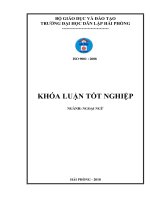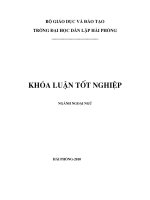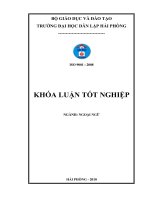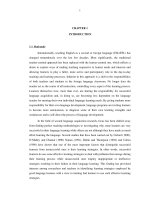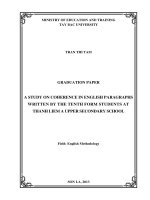A study on hyperbole in short stories of some typical vietnamese and american writers
Bạn đang xem bản rút gọn của tài liệu. Xem và tải ngay bản đầy đủ của tài liệu tại đây (430.86 KB, 62 trang )
..
BỘ GIÁO DỤC VÀ ĐÀO TẠO
TRƯỜNG ĐẠI HỌC DÂN LẬP HẢI PHỊNG
-------------------------------
ISO 9001 : 2008
KHĨA LUẬN TỐT NGHIỆP
NGÀNH: NGOẠI NGỮ
HẢI PHÒNG - 2010
HAIPHONG PRIVATE UNIVESITY
FOREIGN LANGUAGES DEPARTMENT
-----------------------------------
GRADUATION PAPER
A STUDY ON HYPERBOLE IN SHORT STORIES OF
SOME TYPICAL VIETNAMESE AND AMERICAN
WRITERS
By:
NGUYEN PHUONG NHUNG
Class:
NA1002
Supervisor:
TRAN THI NGOC LIEN, M.A
HAI PHONG - 2010
BỘ GIÁO DỤC VÀ ĐÀO TẠO
TRƯỜNG ĐẠI HỌC DÂN LẬP HẢI PHÒNG
--------------------------------------
Nhiệm vụ đề tài tốt nghiệp
Sinh viên: ............................................................Mã số:............................
Lớp: .............................Ngành:....................................................................
Tên đề tài: .................................................................................................
..................................................................................................
.................................................................................................
..................................................................................................
Nhiệm vụ đề tài
1. Nội dung và các yêu cầu cần giải quyết trong nhiệm vụ đề tài tốt nghiệp
( về lý luận, thực tiễn, các số liệu cần tính toán và các bản vẽ).
……………………………………………………………………………..
……………………………………………………………………………..
……………………………………………………………………………..
……………………………………………………………………………..
……………………………………………………………………………..
……………………………………………………………………………..
……………………………………………………………………………..
……………………………………………………………………………..
2. Các số liệu cần thiết để thiết kế, tính tốn.
……………………………………………………………………………..
……………………………………………………………………………..
……………………………………………………………………………..
……………………………………………………………………………..
……………………………………………………………………………..
……………………………………………………………………………..
……………………………………………………………………………..
……………………………………………………………………………..
……………………………………………………………………………..
3. Địa điểm thực tập tốt nghiệp.
……………………………………………………………………………..
……………………………………………………………………………..
……………………………………………………………………………..
CÁN BỘ HƯỚNG DẪN ĐỀ TÀI
Người hướng dẫn thứ nhất:
Họ và tên:.............................................................................................
Học hàm, học vị:...................................................................................
Cơ quan công tác:.................................................................................
Nội dung hướng dẫn:............................................................................
Người hướng dẫn thứ hai:
Họ và tên:.............................................................................................
Học hàm, học vị:...................................................................................
Cơ quan công tác:.................................................................................
Nội dung hướng dẫn:............................................................................
Đề tài tốt nghiệp được giao ngày 12 tháng 04 năm 2010
Yêu cầu phải hoàn thành xong trước ngày 10 tháng 07 năm 2010
Đã nhận nhiệm vụ ĐTTN
Sinh viên
Đã giao nhiệm vụ ĐTTN
Người hướng dẫn
Hải Phòng, ngày tháng năm 2010
HIỆU TRƯỞNG
GS.TS.NGƯT Trần Hữu Nghị
PHẦN NHẬN XÉT TÓM TẮT CỦA CÁN BỘ HƯỚNG DẪN
1. Tinh thần thái độ của sinh viên trong quá trình làm đề tài tốt nghiệp:
……………………………………………………………………………..
……………………………………………………………………………..
……………………………………………………………………………..
……………………………………………………………………………..
……………………………………………………………………………..
……………………………………………………………………………..
……………………………………………………………………………..
……………………………………………………………………………..
2. Đánh giá chất lượng của khóa luận (so với nội dung yêu cầu đã đề ra trong
nhiệm vụ Đ.T. T.N trên các mặt lý luận, thực tiễn, tính tốn số liệu…):
……………………………………………………………………………..
……………………………………………………………………………..
……………………………………………………………………………..
……………………………………………………………………………..
……………………………………………………………………………..
……………………………………………………………………………..
……………………………………………………………………………..
……………………………………………………………………………..
……………………………………………………………………………..
3. Cho điểm của cán bộ hướng dẫn (ghi bằng cả số và chữ):
……………………………………………………………………………..
……………………………………………………………………………..
……………………………………………………………………………..
Hải Phòng, ngày ….. tháng ..… năm 2010
Cán bộ hướng dẫn
(họ tên và chữ ký)
NHẬN XÉT ĐÁNH GIÁ
CỦA NGƯỜI CHẤM PHẢN BIỆN ĐỀ TÀI TỐT NGHIỆP
1. Đánh giá chất lượng đề tài tốt nghiệp về các mặt thu thập và phân tích tài liệu,
số liệu ban đầu, giá trị lí luận và thực tiễn của đề tài.
2. Cho điểm của người chấm phản biện :
(Điểm ghi bằng số và chữ)
Ngày.......... tháng......... năm 2010
Người chấm phản biện
ACKNOWLEDGEMENT
In the process of completing this graduation paper, I have received a
great deal of assistance, guidance and encouragement from my supervisor, my
teacher, my friends and my family.
First of all, I would like to express my deepest thanks to my
supervisor- the leader of the foreign language department, Mrs Tran Thi Ngoc
Lien, M.A. who has given me suggestions on how to shape the study and
always has encouraged continuously, has given me valuable advices,
constructive comments during the time of writing this graduation paper.
Next, I would like to express my gratitude to Mrs Nguyen Thi Yen
Thoa, M.A. and other lecturers in the foreign language department for their
lectures and instructions which help me a lot in completing this study.
I also want to express my sincere thanks to my friends who have
always shared to me their interests, concerns and supports to this study.
Last but not least, I would like to thank my family who has facilitated
me to complete this study.
Hai Phong, June, 2010
Student
Nguyen Phuong Nhung
TABLE OF CONTENTS
PART ONE: INTRODUCTION ............................................................ 1
1. Rationale of the study ........................................................................... 1
2. Aims of the study .................................................................................. 2
3. Scope of the study ................................................................................. 2
4. Method of the study .............................................................................. 3
5. Design of the study................................................................................ 3
PART TWO: DEVELOPMENT ........................................................... 4
CHAPTER I: THEORETICAL BACKGROUND .............................. 4
1. Word ...................................................................................................... 4
1.1. Definition of word ........................................................................... 4
1.2. Types of word ................................................................................. 5
2. Word meaning ....................................................................................... 6
2.1. Definition of meaning .................................................................... 6
2.2. Types of meaning ........................................................................... 7
2.2.1. Lexical meaning ................................................................... 7
2.2.2. Grammatical meaning .......................................................... 9
3. Hyperbole .............................................................................................. 10
3.1. What is hyperbole .......................................................................... 10
3.1.1. Definition of English hyperbole........................................... 11
3.1.2. Antonyms of English hyperbole .......................................... 13
3.1.3. Definition of Vietnamese hyperbole .................................... 14
3.1.4. Antonyms of Vietnamese hyperbole.................................... 16
CHAPTER II: HYPERBOLE IN SHORT STORIES OF SOME
TYPICAL AMERICAN AND VIETNAMESE WRITERS ............. 18
1. Overview of hyperbole in American and Vietnamese short stories. . 18
2. Hyperbole in typical American short stories ..................................... 19
2.1. Structure of hyperbole in typical American short stories ........... 19
2.1.1. Hyperbole in terms of words.............................................. 19
2.1.2 Hyperbole in terms of phrases ............................................ 20
2.1.3. Hyperbole in terms of clauses ............................................ 22
2.1.4. Hyperbole in terms of sentences ........................................ 25
2.2. Meaning of hyperbole in typical American short stories ............ 25
2.2.1. Hyperbole with low level of intensification ...................... 25
2.2.2. Hyperbole with medium level of intensification ............... 26
2.2.3. Hyperbole with high level of intensification ..................... 27
2.3. Stylistic features of hyperbole in American short stories ........... 27
2.3.1. Formal stylistic scales ........................................................ 27
2.3.2. Informal stylistic scales...................................................... 28
3. Hyperbole in typical Vietnamese short stories .................................... 28
3.1. Structure of hyperbole in typical Vietnamese short stories .......... 29
3.1.1. Hyperbole in terms of words................................................ 29
3.1.2. Hyperbole in terms of phrases .......................................... 30
3.1.3. Hyperbole in terms of clauses ............................................. 33
3.1.4. Hyperbole in terms of idioms ............................................. 34
3.1.5. Hyperbole in terms of sentences ......................................... 35
3.2 Meaning of hyperbole in typical Vietnamese short stories .......... 35
3.2.1. Hyperbole with low level of intensification ........................ 35
3.2.2. Hyperbole with medium level of intensification ................. 36
3.2.3. Hyperbole with high level of intensification ....................... 37
3.3. Stylistic scales of hyperbole in typical Vietnamese short stories 38
3.3.1. Formal stylistic scales .......................................................... 38
3.3.2. Informal stylistic scales........................................................ 38
CHAPTER III: IMPLICATION OF THE STUDY ............................ 40
1. Difficulties faced by learners of English in interpreting and using
hyperbole in American and Vietnamese short stories .............................. 40
2. Some solutions .................................................................................... 41
PART THREE: CONCLUSION ........................................................... 45
1. Issues addressed in the study .............................................................. 45
2. Recommendations and Suggestions for further study ........................ 46
References ................................................................................................ 48
Appendix .................................................................................................. 50
PART ONE: INTRODUCTION
1. Rationale of the study
I do not know when I love such the fork songs, idioms and the proverbs in my
country. May be, I am a person who grow up in the sea of the fork songs and
proverbs when I was a child, closing to my grandmother‘s hand and my mother‘s
love. Any when I went to sleeping, I was also heard many fork songs and proverbs
by my grandmother. Up to now, I also remembered clearly some of the fork song
like this:
―Cày đồng đang buổi ban trưa,
Mồ hôi thánh thót như mưa ruộng cày.
Ai ơi bưng bát cơm đầy,
Dẻo thơm một hạt đắng cay muôn phần.‖
Or the proverb likes this:
―Đêm tháng năm chưa nằm đã sáng
Ngày tháng mười chưa cười đã tối‖
At that time, by the smoothly rhythm of my grandmother‘s voices, I just knew
that the fork songs and proverb was very interesting and easy to learn by heart.
When I grew up a little, I studied at primary school, secondary school, high
school and university with many different subjects, especially semantics I realized
that it is the fork songs and the proverbs my grandmother often talked to me that is
outstanding hyperbolical usage. And now, I can analyze the meaning of those fork
songs and proverbs.
In the fork song, ―mồ hơi thánh thót như mưa ruộng cày‖ shows sweat drops
very much. And the meaning of ―chưa nằm đã sáng‖ and ―chưa cười đã tối‖ are
the night of May and the day of October are very short.
This phenomenon step by step attracts me a lot, and that drives me the wish to
study in order to understand it more. And when I started to make a minor
comparison between the way Vietnamese and American use hyperbole, this
linguistic issue totally captivates my attention. Therefore I choose hyperbole as the
major topic in my graduation paper hoping that first I can understand it then help
other Vietnamese learners to grasp the in-depth meanings shown in each
hyperbole. However, because of the time limit and the scope of the study, I only
can focus on the hyperbole used in some typical Vietnamese and American short
stories.
2. Aims of the study
The study is aimed at:
- Figure out common hyperbole used in some typical short stories of American and
Vietnamese writers.
- Analyze the formation and implied means of hyperbole
- Identify common mistakes
- Suggest some effective solutions.
3. Scope of the study
It is too difficult for me to study all hyperboles because of my limited
knowledge and time for this study so I only focus on hyperbole in some short
stories which we often find when reading the stories. I will give some information
on hyperbole and stress on the analysis of the expression of hyperbole in some
typical short stories of American writers which I can compare them to Vietnamese
ones.
4. Method of the study
In this graduation paper, I use some main methods. Firstly, I use quantitative
research including statistical analyze to analyze the data collected. Then I classify
hyperbole. Then, hypothesis testing is the second method in used setting the
hypothesis for the use of hyperbole in typical American short stories and typical
Vietnamese ones, trying to figure out why they are put in use in this or that way.
And finally is comparative research which enables me to find out the differences
and similarities between hyperbole in Vietnamese and American.
5. Design of the study
This study consists of three parts of which the second is the most important
Part one is the introduction which states the reason of the study, the aims of
the study, the scope of the study, the method of the study and the design of the
study.
Part two is Development which is the main content that concludes three
chapters: The first chapter is the theoretical background. It focuses on some
general definitions. The second chapter stresses on the hyperbole in some short
stories of typical American and Vietnamese writers and then finding differences
and similarities between them. The third chapter will give some common mistakes
and solutions, some exercises will provide knowledge about hyperbole.
Part three is the conclusion of the whole study which summarizes the main topic
given in the part two.
PART TWO: DEVELOPMENT
CHAPTER I: THEORETICAL BACKGROUND
1. Word
1.1. Definition of word
Lexicology is the study on stock of the words in a given language. The word is,
therefore, of centre importance in lexicology. The fundamental we should attempt
to answer is ―what exactly do we mean by the term ―word‖ in lexicology‖.
The term ―word‖ is used to specify an intermediate structure smaller than a
whole phrase and generally larger than single sound segment. Therefore, the word
may be defined differently
According to Nguyen Manh Hung (2006:3), word is defined as ―a speech unit
used for the purposes of human communication, materially representing a group of
sounds, possessing a meaning, susceptible to grammatical employment and
characterized by formal and semantic unity‖.
According to Jackson and Amvela (2000:50), word is considered as ―an
uninterruptible unit of structure consisting of one or more morphemes and which
typically occurs with the structure of phrase‖. The morphemes are ultimate
grammatical constituents, the minimal meaningful unit of language. For example,
the different form of the verb ―sing‖, i.e. sing, sings, singing, sang, sung are
separated word grammatically, similarly. Record (v) and record (n) are different
grammatical words.
In general, there are many ways to define word. The word may be defined
differently depending on whether we focus on its representation, the thought which
it expresses or purely formal criteria. We can define word base on the
phonological, lexical, grammatical points of view and semantic. However, we can
see that definition of word according to Hoang Tat Truong seems to be the most
satisfactory.
According to Hoang Tat Truong (1993:11), word is defined as ―A word is a
dialectical unit of form and content, independent unit of language to form a
sentence by itself‖. For example: ―hand, bag, unhappy, come, drink, vocabulary,
forget-me-not‖ and so forth. Each word here can stand independently and it still
has meaning.
Words in English may be classified as: lexical and grammatical words. Lexical
word (including nouns, verbs, adjectives, adverbs) has fairly independent and
meaning in isolations or in series. It was also referred to a ―lexeme‖. A lexeme is
lexical unit of the vocabulary. The term ―lexeme‖ is sometime used to denote a
lexical word and this avoid confusion with the term ―word‖ in general. In contrast,
grammatical word (including articles, prepositions, and conjunctions, forms
indicating number or tense and so on) does not automatically suggest any
identifiable meaning.
1.2. Types of word
Word can be classified into three types: simple words derived words and
compound words by Hoang Tat Truong.
A simple word is one that only consists of root morpheme: ―school, boy, table,
big, blue, talk, begin, next, etc‖
A derived word is one that consists of a root and one or more derivational
morphemes: teacher, employee, unhappiness, enrich,
antidisestablishmentarianism, etc.
A compound word is one that has at least two roots, with or without derivational
morphemes: blackboard, handbag, greenhouse, bluebottle, goody-goody, etc
Words are often considered as linguistic sign, similar certain respect to natural
and conventional signs. They do not have meaning but rather are capable of
conveying meanings which carries both lexical and grammatical meanings of the
word.
2. Word meaning
2.1. Definition of meaning
The question ―what is meaning‖ is one of the questions which are easier to ask
than to answer. The linguistic science at present is not able to put forward a
definition of meaning which is conclusive.
However, the certain fact is that the function of word as a unit of communication
is made possible by its possessing a meaning. Therefore, among the word‘s various
characteristic meaning is the most important.
General speaking, meaning can be more or less described as a way endowing the
word through which a concept is communicated, in this qualities, actions and
abstract notions.
(Nguyen Manh Hung, 2006:43)
More carefully analyzed, the word ―meaning‖ is derived from the verb ―mean‖
and both of them are used like many other English words, in the wide range of
contexts and in several distinguishable senses.
For example, to take the case of the verb, if someone says:
―Smith means well‖
(Nguyen Hoa, 2001:7)
He implies that Smith is well-intentioned, that he intends no harm
―Red flag means danger‖
(Nguyen Hoa, 2001:7)
In this saying, one would not normally imply that the flag had plans to endanger
anyone; one would be pointing out that it is used to indicate the danger in
surrounding environment, such as the use of explosives in the nearby quarry or
deeply lake. After those, we can see that there are many different meanings of the
word ―mean‖.
2.2. Types of meaning
“Some tigers are roaring at the mouth of the cave”
(Hoang Tat Truong, 1993:86)
The above is a meaningful part. One of the smaller parts is the word ―tiger‖
which refers to certain animal. We can call it a referring expression. A tiger
expression is a piece of language that is used as if it is linked something outside
language, some living or death entities or concepts. Another meaningful part is the
verb ―roar‖ which is also linked to something outside of language, an action here
associated with the referring expression ―tiger‖. We call this meaningful predicate
which clarifies something about that entity. Besides, the plural form of noun
―tiger‖ indicating that there is more than a tiger and the tense of the verb ―roar‖
pointing out the time of this action. Obviously, in a sentence, two kinds of meaning
are remained: lexical meaning, in case of the noun ―tiger‖, the verb ―roar‖ and
grammatical meaning (also called functional meaning) in the plural form of noun
as well as the tense of verb.
2.2.1. Lexical meaning
Lexical meaning is one of two types of meanings found in words.
―Lexical meaning is the individual meaning; each word has in the system of
language. It is the realization of concept and emotion and bring together the
different forms of one and same word‖
(Hoang Tat Truong, 1993:53)
When we hear or see the word ―head‖, for example, our concept is realized and
the picture or image of a leader, a part of person, part of bird occurs to our mind.
Therefore, this realization is called lexical meaning.
According to Hoang Tat Truong, lexical meaning is divided into two types.
They are direct meaning and indirect meaning.
―Direct meaning which is also called literal meaning, is the meaning that
directly denotes something without comparing it or associating with the other
thing, i.e. we do not need the context‖
(Hoang Tat Truong, 1993:57)
E.g.:
“Can you carry the bag for me?”
“I am sorry, I can’t. My hands are hurting‖
The word ―hand‖ is the part of the body to do something or to hold
something…We need not the comparison or association with other things to
understand it. So hand in the sentence is direct meaning. It differs from the indirect
meaning which is presented in the following:
―Indirect meaning is the meaning that indirectly denotes something in the
association with other things, i.e. we need contexts to understand. Indirect
meaning also called figurative meaning‖
(Hoang Tat Truong, 1993:57)
When hearing the word ―key‖, for example, we are most likely to think of a
small instrument used to open or lock the door. This is the direct meaning of ―key‖.
On the other hand, if we come across the sentence: ―He said that always listening
to other ideas is the key to success‖, we will think of meaning of the way to gain
the success in life‖ which is indirect meaning.
2.2.2. Grammatical meaning
―Grammatical meaning can be defined as an expression in speech of relation
between words based on contrastive features of arrangement in which they occur.
This meaning is abstract and generalized‖
(Hoang Tat Truong, 1993:53)
Every language has grammatical systems. We can explain what grammatical
meanings are by showing how differ from the sentence ―some student are playing
football‖ to others that have the same referring expression and predicate. The
grammatical system of English possibly makes the expression of the meaning like
these:
Statement vs. Question:
Some students are listening to
Are some students listening to
music
music
Affirmative vs. negative
Some students are listening to
Some students are not listening to
music
music
Present continuous vs. past
Some students are listening to
A student is listening to music
music
Plural vs. singular
Some students are listening to
A student is listening to music
music
Indefinite vs. definite
Some students are listening to
The students are listening to music
music
From the above comparison, we can conclude that grammatical meanings are
expressed in various ways: the arrangement of words (referring expression before
the predicate, for instance) by grammatical affixes like the -s attached to the noun
―student‖ and the –end attached to the verb ―play‖; and by grammatical words or
functional words like the ones illustrated in those sentences be (in the form are),
not, some, the. These words do not automatically suggest any identifiable meaning.
They are elements like prepositions, articles, conjunction, forms indicating number
or tense, and so on.
All in all, lexical and grammatical meanings do not exist separately but always
close together to make up the meaning of word.
3. Hyperbole
3.1. What is hyperbole?
Do you know what a hyperbole is? This graduation paper will help you
understand basically hyperboles using interesting examples of hyperboles…
The word ―hyperbole‖ has its origin in the Greek language. Hyperbole is a
figure of speech that is a complete exaggeration and which denotes extremes. So to
say, ‗I laughed so much I nearly died‘ is an example of hyperbole. It denotes that
something was very funny and that someone laughed a lot, but it is extremely
unlikely that someone laughed so much that they almost died. However, the phrase
gives us a sense of just how funny something was
Hyperbole exists in many languages, but in English, it is very common in both
everyday speech and in written English. In written English, from poems, dramatics,
plays, novels, stories to other kinds of literature, hyperbole is used quite popular
and widely to evoke strong feelings or to create a strong impressions. It tends to be
used within informal settings or for literary effect. It is not, for example, regarded
as good practice to use hyperbole within business English; it could be regarded as
unprofessional.
I would not use phrases such as, ‗bursting with rage’ with a client. I would
instead, express my disappointment and frustration. However, if I were writing a
story, a poem, or a simple informal email, and then the use of hyperbole is
perfectly acceptable and is actually a way of giving added depth and quality to my
writing. Hyperbole is therefore a literary tool or a very informal tool and it should
not be used in formal settings.
As mentioned on the scope of the study, I only focus on hyperbole in short
stories of some typical American and Vietnamese writers that are the small
representing of hyperbole in literature.
3.1.1 Definition of English hyperbole
There are many definitions of hyperbole in English as the following: ―Hyperbole
is a figure of speech which is an exaggeration. Persons often use expressions such
as "I nearly died laughing", "I was hopping mad" and "I tried a thousand times."
Such statements are not literally true, but people make them to sound impressive or
to emphasize something, such as a feeling, effort, or reaction.”
( />Wikipedia English, The Free Encyclopedia defines hyperbole as ―Hyperbole
(pronounced/ haipərbəli/ or /hypərbuhli/), (/hypərbəul/ is mispronunciation) is
a figure of speech in which statements are exaggerated. It may be used to evoke
strong feelings or to create a strong impression, and is not meant to be taken
literally. Hyperbole is used to create emphasis. Some examples include: "He has a
brain the size of a pea‖. ―I could eat a horse‖. ―I've heard that a million times‖.
―She is a hundred feet tall”.
Webster‘s Revised Unabridged Dictionary (1993): ―hyperbole is a figure of
speech in which the expression is an evident exaggeration of the meaning intended
to be conveyed, or by which things are represented as much greater or less, better
or worse, than they really are; a statement exaggerated fancifully, through
excitement, or for effect‖.
William Shepard Walsh defines hyperbole is that: (Gr. "excess," "overstrained
praise," etc.), a recognized figure of rhetoric, meaning an extravagant statement or
assertion, which, when used for conscious effect, is not to be taken too seriously or
too literally. Yet the hyperbole is often used unconsciously by the men of vivid yet
unbalanced imagination whom the world sometimes calls liars and sometimes
fools.
Hyperbole (from the Greek hyper, beyond, and bulletin, to throw), is an
exaggerated form of statement and simply consists in representing things to be
either greater or less, better or worse than they really are. Its object is to make the
thought more effective by overstating it. Here are some examples:—"He was so
tall his head touched the clouds." "He was as thin as a poker." "He was so light
that a breath might have blown him away." Most people are liable to overwork this
figure. We are all more or less given to exaggeration and some of us do not stop
there, but proceed onward to falsehood and downright lying. There should be a
limit to hyperbole, and in ordinary speech and writing it should be well qualified
and kept within reasonable bounds
( />In show business, hyperbole(known as hype or media hype) is the practice of
spending money on public relation in a attempt to bolster public interest in(for
example) a movie, television show, or performing artist. Often the entertainment
value of the thing being hyped is exaggerated. Consequently, hype (but not
traditional, literate hyperbole) has a bad connotation.
Hyperbole is the effect way to color the speech of a character in a short story, or
to make a point effectively an a humorous piece of writing
E.g. ―I laughed so much I nearly died‖ is an example of hyperbole, it denotes
that something was very funny and that someone laughed a lot, but it is extremely
unlikely that someone laughed so much that they almost died. However, the phrase
gives us a sense of just how funny something was.
3.1.2 Antonyms of English hyperbole
In rhetoric, some antonyms of hyperbole are meiosis, litotes, understatement,
and bathos (the ‗let down‘ after a hyperbole in a phrase)
Understatement (Litotes and Meiosis): as the word implies, is the opposite of
hyperbole (or overstatement). It achieves its effect of emphasizing a fact by
deliberately understating it, impressing the listener or the reader more by what is
merely implied or left unsaid than by bare statement. Meiosis is merely
understatement without the use of negatives. Nowadays, subdivision into litotes
and meiosis is rarely done, except by precisionists. Modern English dictionaries
tend to treat the tree terms - understatement, litotes, and meiosis as synonymous.
Sometimes understatement alone is used as the name for this figure of speech,
litotes and meiosis being considered archaic. Understatement, unlike hyperbole, is
often more difficult for students of EFL to identify or understand. This is because
the comprehension of an understatement involves more than form; social-cultural
factors, as well as the situational context, are relevant to understatement
For the sake of politeness and pleasantness, people often use another formation
called understatement, which, is not to state something fully or adequately.
Understatement, as the word suggests, is ―a statement that is not strong enough to
express how good, bad, impressive etc something really is‖.
―Understatement achieves its effect of emphasizing a fact by deliberately
understating it.‖
―Understatement is usually divided into litotes and meiosis. Litotes is
understatement by using a negative statement instead of a positive one‖
Examples:
a. She is very ugly. --- She is not particularly good-looking.
b. He was quite rich. ---He was a man of no mean wealth.
In sentence (a), ―not particularly good-looking‖ is more neutral and vague than
―ugly‖, so the employment of this euphemism successfully avoids annoying the
person concerned. Sentence (b) has something to do with personal affairs.
Westerners don‘t like others to talk about their private affairs. Wealth belongs to
one‘s privacy, so it is more polite to use a roundabout way to talk about it when
you
have
to
―Meiosis is merely understatement without the use of negatives‖
Examples:
c. Her daughter is in prison. ---Her daughter lives under the government’s
expense.
d. I can’t promise. ---Sorry, this is in fact more than I can promise.
―Prison‖ in sentence (c) is an unpleasant word. General speaking, people are
sensitive to the word ―prison‖ if one is in prison, you had better avoid mentioning
―prison‖ in front of his relatives. Sentence (d) is a refusal. When you refuse
someone, indirect words will get a better result, for they will not
make him lose face.
By using understatements, the speakers do not seem to be so cruel to others whom
they speak something upsetting to.
3.1.3 Definition of Vietnamese hyperbole
Hyperbole in Vietnam has many ways to define and name, especially to name it.
In other way, it has many synonyms. For example, we can call hyperbole is ―ngoa
dụ”_the Chinese-Vietnamese word; “nói quá”; “thậm xưng”, “khoa trương”;
“cường điệu” likely some name of hyperbole in English(hyperbole, overstatement,
exaggeration..)
Those following are some definitions of hyperbole in Vietnamese:
―Ngoa dụ(phóng đại, khoa trương, thậm xưng), biện pháp tu từ, dùng lối nói
cường điệu một mức độ, tính chất, đặc điểm nào đó của đối tượng nhằm mục đích
làm nổi bật bản chất của đối tượng cần miêu tả, tăng thêm tính biểu cảm của lời
nói.” This means that hyperbole is a figure of speech using the overstatement in
some property, level, and characteristic of object to set off its‘ characteristic which
is described and to evoke strong feelings of speech.
E.g.

